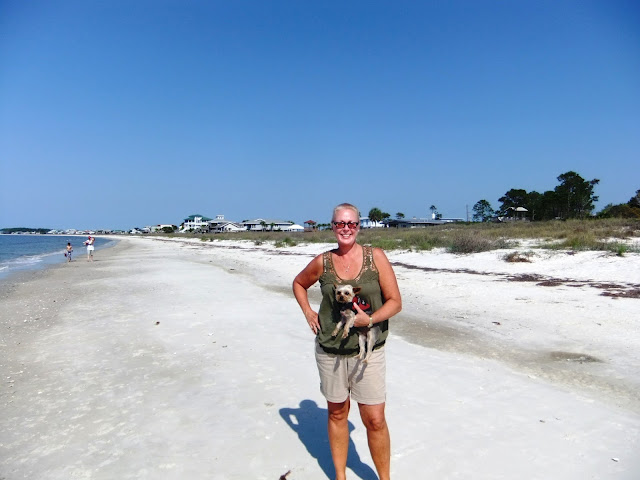The time here at Carrabelle has flown, with all the hubbub and exciting doin's here at the RV park.
First, we are very proud to say that Buddy won the "best-dressed dog" contest, paws down. I think the competition could have been a bit stiffer, but whatever.
 |
| I call this winning ensemble the "organ grinder monkey" look, complete with tail. (Beau called it a gaudy pimp look.) |
 |
| Before I embellished the hat.... |
 |
| The cute competition. But really. You knew who had to win, didn't you? |
Second, we had the corned beef and cabbage dinner redux at Ruth and Carl's place. The excitement never stops, people! Lots of laughs, and great food, again.
 |
| Beau seems to have a lot of fun wherever he goes. He's a cute old coot. |
 |
| Kay (in the yellow) with our hosts, Ruth and Carl. Nice antennae -- maybe we should call her "Kaytee-bug'? |
 |
| Kenny, standing at right, always carries extra beer in a special fanny pack. Just can't be without the brew, I guess. He is a very funny fellow. |
 |
| Kay and Carl, looking pretty darned cozy together. (They are married to other people, but hey, let's not start any talk, folks.) |
Bad News, But Good Friends
A moment of silence.... We have received unfortunate news on the Boo (our Malibu). On the way to Crawfordville, a town about 40 minutes away, the Boo started acting up. We hoped for the best on the long return drive, but the hiccuping continued. We somehow made it back to Carrabelle, and the Boo limped into the local auto shop. And then we received the grim news: The transmission was shot. And we had nearly made it to 90,000 miles!
Now we are without a car for at least four days and may have to extend our stay beyond April 2nd here. Crossing our fingers for a fix by Monday, folks. AND THERE GOES THE BUDGET. A cool two grand or so that we had not anticipated spending. Ouch! We really have no choice, though. (Looks like I will be applying for that WalMart "greeter" position sooner than planned.)
The Boo has been a great car up to now. In fact, the mechanic raved about the Malibu's long life and overall dependability. Oh yeah, sure, mister mechanic, it is super swell -- OTHER THAN THE #$!&;#$$%%!! TRANSMISSION IMPLOSION! Jeesh.
Anyway, enough of that.
Carl and Ruth, taking pity on the two poor pitiful seniors without wheels, kindly offered to be our tour guides for the day on Thursday, first showing us one of the local hot spots, the Dwarf Cypress preserve in Tate's Hell State Forest. Quick explanation: There was a guy named Tate who hunted in these woods and got bitten by a snake, and somehow crawled to civilization before dying. His last words were "I have just been in Hell." This is Beau's explanation of the moniker for the place. Apocryphal story? Don't know. Don't care.
The Dwarf Cypress Boardwalk allows you to view one of the largest groves of these trees anywhere in the United States. Many of these "Bonsai" cypress trees are more than 300 years old, and most do not grow more than 6 feet tall -- no one knows why, though. They are genetically the same as normal sized cypresses. It could be the soil, which is low on nutrients, or the fact that the area historically had been flooded much of the year. A fascinating mystery here on The Forgotten Coast.
 |
| In the middle of nowhere on our way to the cypress forest...not a sign of any life anywhere... |
 |
| ...other than the apiaries scattered along the road. One source of the famous Tupelo honey they sell in this area. (Beau thought apiaries had apes in them-- stoopit!) |
 |
| The boardwalk leading to the Dwarf Cypress area. |
 |
| Some water lilies in bloom. |
 |
| In front of the Dwarf Cypress forest. |
Very cool! Then it was on to the Apalachicola National Estuarine Research Reserve. The reserve was established to educate the public and help protect the various habitats of the Apalachicola River and Bay system.
It is also yet another example of how well Florida executes these public spaces/educational centers. It is a beautiful place, showcasing the local flora and fauna, and helping adults and schoolchildren understand the local area and its importance.
For instance, we learned that the Apalachicola Bay area is one of the most productive natural systems on the continent, incorporating habitats "ranging from upland pine and bottom-land hardwood forests to marshes and oyster beds to protective barrier islands." And because fresh water and salt water meet in the bay, Apalachicola is an estuary where organisms from both the river and the gulf feed and reproduce. Like good ol' Long Island Sound back home.
Cool, huh?
 |
| Ruth at the Estuarine Research Reserve, pretending to be an oyster-woman. |
 |
| Carl studies a display. |
 |
| A lovely turtle whose name I unfortunately forgot. |
 |
| I think this might be a Florida softshell turtle. At any rate, it has an impressive neck, yes? |
It was so nice of Carl and Ruth to drive us around and show us these unique points of interest in the Carrabelle area. We loved it.
Another great day! Thanks, guys. Oh -- and we capped off the excursions with this sighting of a bald eagle. What a thrill.
 |
| A little fuzzy, but there he is in all his glory. |
Tanks, Panky







































